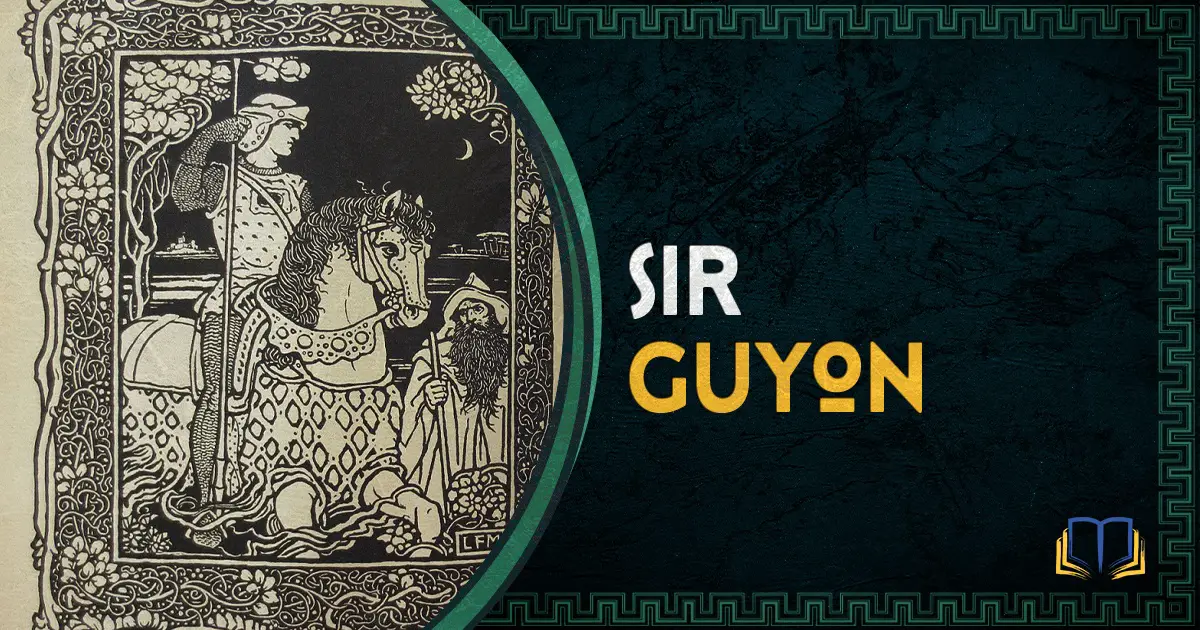Sir Guyon is the primary character in book 2 of Edmund Spenser’s The Faerie Queen. He is known as the knight of temperance, temperance being the primary virtue of book 2.
He is a tricky knight to figure out, mostly because the concept of “temperance” is a difficult virtue to pin down. After all, what might be temperate for one situation could be overkill in another. So let’s talk about that for a second…
The Virtue of Temperance
Simply put, temperance means walking the middle Road of moderation and self-restraint, and thereby avoiding different extremes on either side.
To use an easy analogy: the porridge is either too hot, too cold, or just right. It’s that last Goldilocks zone that represents temperance.
But there is a problem: temperance is often dependent on the situation you are in.
For example, using violence to defend yourself from an enemy is fine, this is temperance. You could argue that even killing your attacker would be justified and not out of line.
However, if you committed the same violence on an innocent person, it is no longer temperate, it is an extreme.
Likewise, when does this assertion for self-mastery become a burden? If you start imposing rules of self-mastery on others, doesn’t that seem a little extreme?
It is a moral conundrum that can probably never be fully answered, but Edmund Spenser does do a decent job in book 2 of The Faerie Queen.
For Sir Guyon, temperance typically means mastering oneself and not giving into unwholesome temptations such as lust, greed, violence, etc.
The book allows us to explore different situations where temperance might be needed, and what form that temperance takes. For example, in Alma’s castle, temperance means showing curiosity, whereas when Guyon is confronted by Phaedria, temperance means denying her and leaving straightaway.
While these might seem like complete opposites, it is an attempt by Edmund Spenser to explore the theme from multiple angles, as any good theme should be.
Sir Guyon: Timeline of Events
- Guyon begins his adventures with the Palmer and runs into Archimago who claims that the Redcrosse knight is violating Duessa.
- Guyon attacks the Redcrosse knight but soon realizes his mistake and the two make up.
- Guyon finds Amavia and her baby son and learns the tragic story behind her husband’s death.
- Guyon takes the baby to a castle where he fights Huddibras and Sansloy, before Medina makes peace.
- Guyon leaves the baby with Medina.
- He and the Palmer continue on until they encounter Occasion and Furor, Guyon fights them, and also fights Atin and Pyrocles and wins.
- He hears the story from Phaon that is similar to William Shakespeare’s Much Ado about Nothing.
- Guyon continues to the Idle Isle where he confronts Phaedria and briefly fight Cymochles.
- He continues on alone and encounters Mammon who tempts him with riches and takes him on a trip through the underworld.
- He returns from the underworld unconscious, and is saved by an angel and the Palmer.
- Pyrocles and Cymochles show up but Guyon is saved by the timely arrival of Prince Arthur.
- He and Arthur go to Alma’s castle and he spends a lot of time reading the history of fairyland.
- He leaves Alma’s castle and continues on with the Palmer to the Bower of Bliss.
- At the Bower of Bliss, he confronts Acrasia and captures her, destroying the Bower of Bliss and taking her away.
- After this, he sends Acrasia to the Faerie Queen and goes with Arthur on many adventures.
- They eventually bump into Britomart, who gets the better of him, but they soon become friends.
- Later in the poem, he loves Florimell as soon as he sees her and helps Artegall find peace.
A Low-Action Knight
Sir Guyon does not have much of the same heroics and action that other knights have, largely because he is a knight of temperance, and so he is more likely to use reason and talking to get himself out of the situation, rather than violence.
After all, the climax of the book 2 is when Guyon captures the main villain of the entire plot by throwing a net on her, not exactly St. George-level heroics.
Ultimately, this comes back to the idea of what temperance actually means, and how to be a temperate person but still be a heroic knight-like figure.
Only time will tell.
See our complete list of Arthurian characters for more entries like this one.
Arthurian Bibliography
- Norris Lacy, Geoffrey Ashe, Debra Mancoff – The Arthurian Handbook (Second Edition)
- Alan Lupack – The Oxford Guide to Arthurian Literature and Legend
- Ronan Coghlan – The Illustrated Encyclopaedia of Arthurian Legends
- Anonymous – Lancelot-Grail, the French Vulgate
- Sir Thomas Malory – Le Morte d’Arthur
See also my ever-expanding list of primary and secondary sources.



